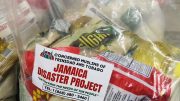The practice of our beloved Prophet Muhammad, peace be upon him, was to leave his blessed mosque and go to an open space on the outskirts of Madina for Eid prayers. Muslim communities, to this day, in several parts of the globe, faithfully implement this practice, leaving the four walls of the mosque and venturing outdoors into nature to praise the Almighty and perform the Eid prayers.
On the beautiful tropical island of St. Lucia in the Caribbean, this Prophetic tradition takes on a special meaning. The mountainous landscape of the island’s interior gives way to splendid bays, beaches and pristine water on its coastline, especially along the western Caribbean Seaside. It is on one of these beautiful beaches, Vigie Beach, that the small but growing Muslim community of St. Lucia journeyed to perform their Eid prayers. A practice started three years ago for both Eids, reportedly at the suggestion of the community’s sisters.
My wife and I, from neighbouring Barbados, wishing to experience such an Eid, travelled to the island for Eid al-Adha. It was absolutely worth the trip. St. Lucia’s Muslim community is small, numbering around 350 Muslims. Sabir Nakhuda, in his book “Muslims of CARICOM (Caribbean Community)” writes:
“After the end of slavery, East Indian indentured labourers were brought to work on the small plantations scattered across the island of St. Lucia. Some of them came with names such as Ali, Din, Khan and Anwar. Muslims, as a community on the estate, were able to recreate their Islamic environment and retain both their language and Islamic culture. After the end of the indentureship, many of the Indians, both Hindus and Muslims, returned to India, while others went to other Caribbean islands where there were sizeable Indian populations. Islam resurfaced in Saint Lucia when a former ‘Altar Boy’ in the Roman Catholic Church, Herbert John, embraced Islam in 1973 and adopted the name Abdul Rabb (Slave of the Lord). He returned to St. Lucia in 1995 and immediately created Islamic awareness among the St. Lucians from his attire and mannerisms, which led the locals to inquire about his faith. He used these opportunities to speak to them about Islam, and this effort resulted in a handful of early converts to Islam who were all locals.”
Our very kind and gracious host, Brother Abdullah Allain of Masjidul Awwal and his family, drove us to the beach for the Eid prayers. As we arrived, the brothers and sisters were busy setting up. Tents, tables, chairs and covering for the sand where we would pray, all being laid out for the Eid celebrations. Young children were running along the beach and enjoying the picturesque surroundings.

St Lucia Congregants listening intently to the Eid sermon.
The sun was beginning to peep out over the hills in the distance of the bay, and its rays glistened on the calm waters of the Caribbean Sea. It was this spectacular view that worshippers had as we sat in rows under the coconut and almond trees, awaiting the Imam and listening to the sound of waves breaking on the sandy shore while reciting the takbeer of Eid.
Imam Shaykh Moukhtar of Masjid Ghuroba, a graduate of the Islamic University of Madinah, led the prayers and delivered the sermon. The two masjids in the capital city of Castries, not far off, and some Muslims from the south of the island (an hour away), Vieux Fort, come together for the Eid prayers and celebrations at this beach.
The Imam reminded us of the importance of maintaining taqwa (consciousness of God) in our lives and living a responsible life in submission to Allah’s commands, as was the practice of Prophet Abraham, upon whom be peace. He reflected that Prophet Abraham was prepared to sacrifice his beloved son, Ishmail, peace be upon them both, following the commands of Allah. We also must be ready to sacrifice what we love, as the Creator demands.

The Author enjoying the beach view
Eid prayers gave way to a breakfast featuring a diverse array of food items, including St. Lucian delights, hummus, an Arabic salad, and a specially brewed local cocoa tea. The food complemented the occasion and made it even more special. Games, sea baths, a trampoline for the children, and horseback riding on the beach all added to the joy and activities of the morning. With Zuhr (midday) prayers completed, lunch was next, and that included another St. Lucian speciality, curry goat.
The message of the sermon, the joy of Eid, the fellowship of the Muslim community, and the tranquil beauty of the space we occupied all came together to make the Eid observance in St. Lucia a truly blessed experience.
The sacrifice of the animals took place the next day, which included a trip into the mountainous countryside near a river. We opted for the island tour and thus missed the opportunity to be part of the St. Lucian Muslims’ way of doing their Eid sacrifices.
Saint Lucia is an island country in the West Indies in the eastern Caribbean. It is located north/northeast of the island of Saint Vincent, northwest of Barbados and south of Martinique. It covers a land area of 617 km² (238 square miles) and has an estimated population of over 180,000 people as of 2018.
The first proven inhabitants of the island, the Arawaks, are believed to have been the first to settle on the island in 200–400 CE. In 800 CE, the island was taken over by the Kalinago. The French were the first European colonists to settle on the island, and they signed a treaty with the native Caribs in 1660. The English took control of the island in 1663. In the ensuing years, England and France fought 14 times for control of the island; consequently, control over this immensely valuable geopolitical position changed frequently. Eventually, the British took complete control in 1814. Because the island often switched between British and French control, Saint Lucia was also known as the “Helen of the West” after the Greek mythological character Helen of Troy.
As a volcanic island, Saint Lucia is very mountainous, with its highest point being Mount Gimie, at 950 metres (3,120 feet) above sea level. The Pitons, two mountainous volcanic plugs, form the island’s most famous landmark. Saint Lucia is also home to the world’s only drive-in volcano, the Sulphur Springs. Visiting the Pitons and going into the crater and sulphur springs is a must if one visits the island.
The cuisine, the lovely beaches, the warmth, the natural beauty of St. Lucia and the kindness of the Muslims combine to make this Caribbean Island a place to visit.
Our sincerest gratitude to Brother Abdullah and his family and the Muslims of St. Lucia for the kind hospitality and welcome as we celebrated a memorable Eid ul Adha 2025 with them on their beautiful island. A truly tropical, Caribbean-style Eid celebration worth experiencing.




